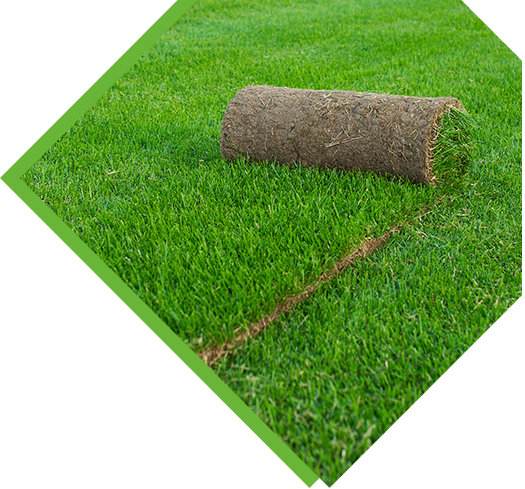Maintenance of roll-out lawns

Fertilizing the lawn - general rules
Consistent fertilization of roll-out lawns is essential if we want to obtain beautiful and dense grass that will delight the eye with its pristine greenery in the period from early spring to late autumn. In the case of roll-out lawns, mineral fertilizers will be most appropriate. It is important to maintain the appropriate proportions of N:P:K macronutrients. The optimal level of this ratio is 6:2:4. To obtain the effect of a uniform colour and proper growth, fertilizers must be distributed evenly.
Fertilizing the lawn with nitrogen
Nitrogen affects the regrowth and development of grasses and determines their colour. This is because this element increases the chlorophyll content in leaves. The first spring nitrogen fertilization of the lawn should be carried out when the temperature of the upper soil layers rises to about 5°C and the grass is well raked. Nitrogen is not used in fall. When entering the dormant period, the grass must not be too lush. For the fertilization of intensively used and irrigated lawns, the annual nitrogen dose is from 3.0 to 4.0 kg N/100 m2.
The use of phosphorus to fertilize turf
Phosphorus is used to improve the development of the root system of the roll-out lawn. The element easily transforms into compounds that are difficult to absorb for plants, especially in acidic soil, but it can be reactivated by microorganisms. The doses of the fertilizer depend on the type of soil and are on average 0.6-1.3 kg per 100 m2. Higher doses are used for sports and carpet lawns.
Beneficial effect of potassium on the soil
Compact soils (clayey, clay) are usually rich in potassium compounds that are available for plants. However, the problem of shortages may appear in the case of light, sandy and peaty soils. Potassium has a positive effect on the regulation of plant water management and the course of photosynthesis. It also increases grass resistance to diseases and frost. Potassium is easily rinsed out into the deeper layers, so the annual dose should be applied twice or three times, especially in fall.
Liming the lawn
Liming is needed mainly in acidic soils (with a pH below 5.5). In such a case, calcium can significantly improve the pH of the soil, and also helps the grass to use up phosphorus and activates potassium. Calcium also accelerates the decomposition of humus and thus releases nitrogen.
Everyday lawn maintenance - mowing
Mowing is the basic maintenance treatment for any lawn. Thanks to mowing, we obtain an even surface of grass of an appropriate height. This procedure has a positive effect on the growth and propagation of plants, as it improves their health and resistance to pests. We adjust the mowing height depending on preferences and weather conditions. To keep the roll-out lawn in perfect condition, use lawn mowers with sharp blades, preferably equipped with grass catchers. If they are missing, the mowed grass should be raked and removed from the lawn as soon as possible.
Verticulation
The purpose of verticulation is to prevent the grass from becoming felted. During the procedure, felt formed from dying grass shoots and mowing remains as well as perennial weeds are removed. Felt has features similar to peat - when dry it is highly hydrophobic and has a negative effect on the lawn. It absorbs water and holds back nutrients that cannot reach the grass. When the grass felt reaches a significant thickness, it also prevents gas exchange in the soil and reduces the penetration of fertilizers. Therefore, verticulation is essential to obtain a perfectly maintained lawn. Thanks to it, airing of the root layer and the planting zone is achieved. Due to the optimal moisture content of the substrate, the best time to carry out the procedure is the beginning of spring vegetation. After verticulation, it is essential to remove any dead plant parts.
The first verticulation can only be done in the second year after laying the roll-out lawn.
Aeration of the lawn - better water management
As a result of use, the upper 5 to 8 cm of the base of the lawn gradually becomes denser. This has a negative effect on the growing conditions of the grass, as the pore size is reduced, thus reducing water absorption and gas exchange. To prevent this, the degree of compaction should be reduced from time to time by means of aeration. Aeration causes the felt to be perforated, thanks to which gas exchange, nutrient management and water management are significantly improved. Various opinions can be found in literature on the number of punctures required per m2 of lawn. Typically, it is stated that 800 to 1,000 punctures are required for the aeration to have the desired effect. Our extensive practice shows, however, that 400-500 punctures per square meter of substrate is the optimal standard. Aeration works can be carried out from April to September.
Sand - an additional lawn maintenance treatment
Adding sand improves the substrate’s water permeability, which results in the appearance of new roots, stolons and shoots. Adding sand should be performed once a year, after verticulation or aeration. For this purpose, loose sand with a grain size of 0.6-2.0 mm is needed.
Fighting diseases and weeds
Fighting diseases is a separate and broad issue. Generally speaking, it must be emphasized that proper maintenance is the best prevention. As an experienced producer of roll-out lawns, thanks to the appropriate selection of species, we are able to choose mixtures characterized by very high resistance to diseases. However, you cannot be 100% sure that you will manage to avoid them, as in the case of the occurrence of weeds or pests. If there is a concern that the lawn may suffer, it is best to call a professional immediately, who will recommend appropriate remedies. In particularly difficult cases, it is necessary to use chemicals. In order not to worsen the situation and to carry out all actions properly, it is necessary to seek professional advice. At the same time, remember to always follow plant protection regulations.




